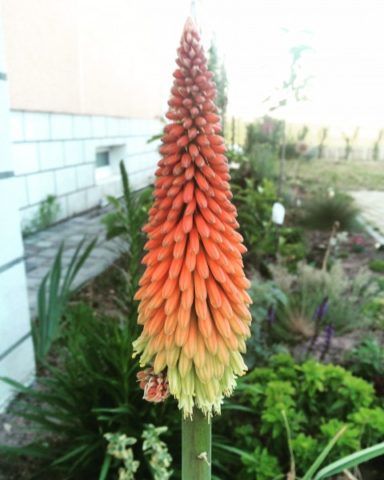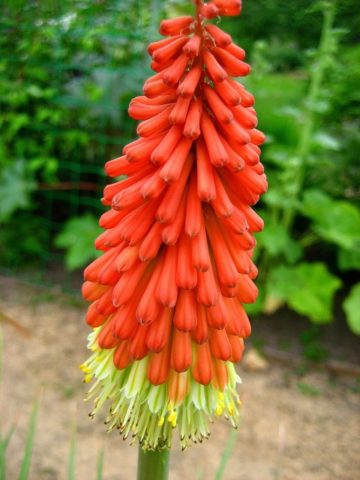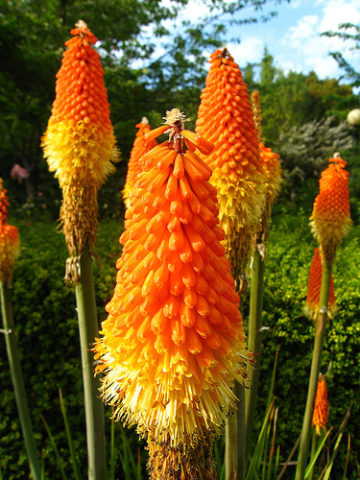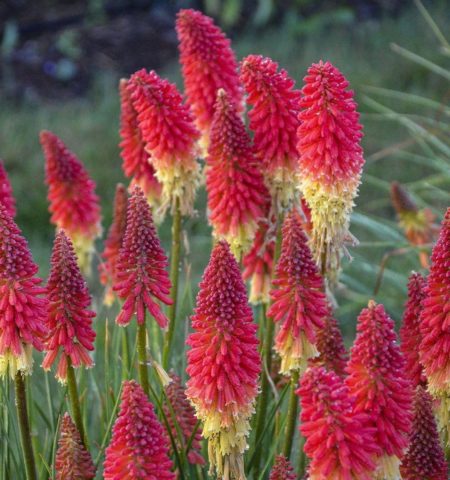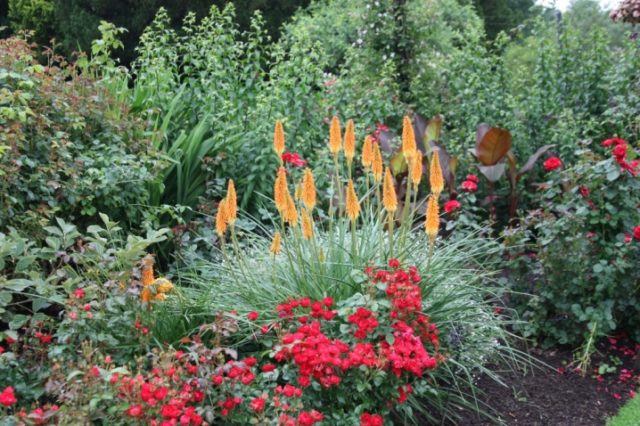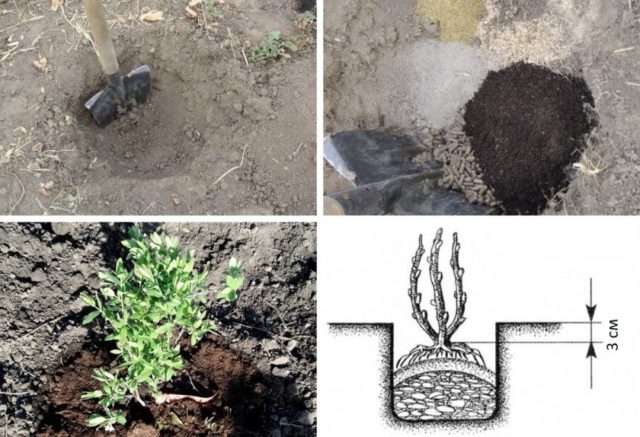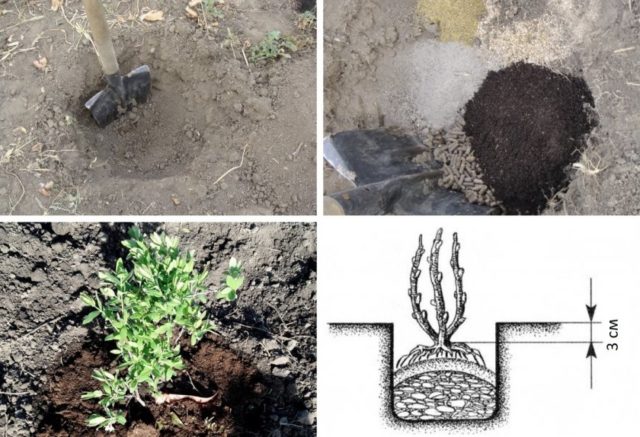Content
Caring for and growing Kniphofia will be a lot of fun. Indeed, a plant of amazing beauty will appear on the site. It is a representative of the Asphodelic subfamily, the Xantorreidae family. Under natural conditions, the plant is found in eastern and southern Africa and on the island of Madagascar. It is located above sea level at an altitude of about 4000 m.
There are 75 species in the family, but only a few hybrids of bniphophy are planted in the gardens. Other plant names: kniphofia, tritoma.
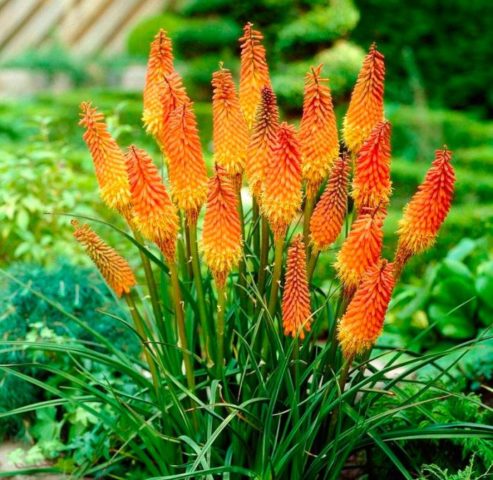
The plant was named after the botanist from Germany Johann Jerome Kniphof
Botanical description
In the photo, the knifofia on the flowerbed looks original. It is a flowering perennial, evergreen in warm regions. The height of the bush, depending on the species and variety, ranges from 6 cm to 3 m. The rhizome of the plant is short, but thick. The root rosette is represented by leathery sword-shaped leaves. A long peduncle grows from the socket, it is noteworthy that it is completely naked.

Gray-green leaf blades and bright spike-shaped buds of an exotic plant will decorate any garden
Flowering features
The bud blooms at the very top of the stem. It consists of small flowers and resembles a sultan or a multi-colored cone. Knifophy buds can open in different ways. On some plants they are directed downward, on others they look up. The color of the petals is from deep red to yellow.
The buds bloom in the middle of summer. But even after the end of flowering, the decorativeness of the plant does not disappear. In place of the bud, a fruit-box with seeds is formed.
Winter hardiness of knifofia
The African flower, even after selection, does not have high frost resistance. Its limit is no more than - 15 ° С. That is why, when growing knifofia in the suburbs and in more severe climatic conditions, for the winter, the bushes are dug up, planted in boxes with drainage. After falling asleep with compost, the plants are removed to a room where the temperature does not drop below + 8 ° C.
Popular types
Breeders have created new plants based on wild-growing crops. Among hybrids, several types of knifophy are especially popular. A brief description, characteristics of the species and varieties of an exotic plant will help flower growers make their choice.
Berry knifofia
Berry knifophyta (Kniphofia uvaria) naturally grows in one place - in the Cape province. This is the oldest (since 1707), tall, strong species, the stems grow up to 2 m. The gray-green leaves of the plant in the shape of a sword reach a length of 50 cm. Knifofia forms large inflorescences (up to 25 cm). The lower part is yellowish green, the upper part is coral red.
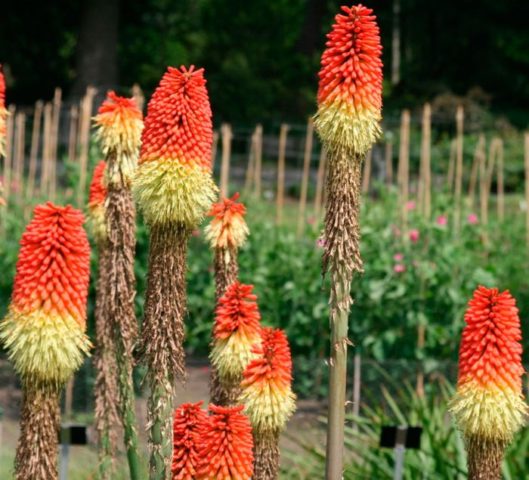
Blossoming of cnifophya is long-lasting, decorative effect keeps for 2 months
Hybrid knifofia
The varieties of kniphofia hybrid (Kniphofia x hybrida) were obtained using berry kniphofia.
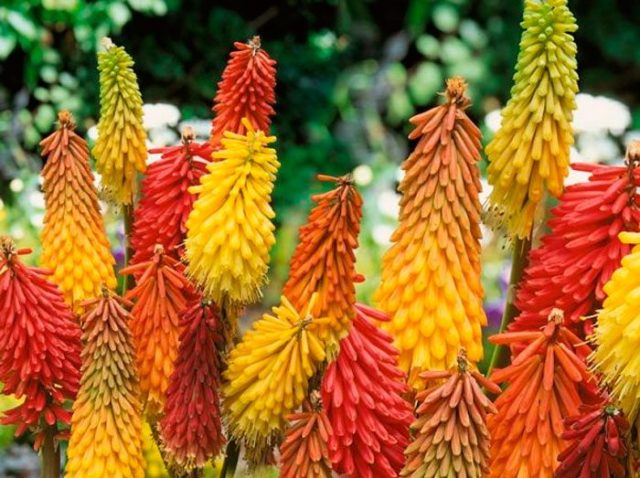
Elegant sultans of hybrid knifophy have been decorating the garden for more than 2 months
Most often, flower growers pay attention to the following options:
- Variety Abendsonne with peduncles growing up to 120 cm.
This plant has a yellow bud below, red on top
- The height of the Cardinal is about 1.2 m. The flowers in the ear are fiery red.
Flowers bloom from bottom to top, so the Cardinal variety cnifofia pleases the eye for a long time
- Bernocks Triumph variety is undersized (up to 60 cm). The color palette is deep orange.
From a distance, it seems that the entire bud of Bernox Triumph is the same color, in fact, the bells below are much lighter
- Indiana is a medium-sized plant. Its height is no more than 100 cm.
Red-orange Indiana cnifophyta petals
- The Rocket variety has inflorescences of a red-cinnabar shade. They are located on long peduncles (about 130 cm).
The Rocket variety is planted by many gardeners against the background of conifers.
Knifofia Tukka
The plant is short, no more than 80 cm. Foxes are xiphoid, their length is about 40 cm. Unlike other species, this cniphophia has an ear of only 15 cm. It has red-yellow bells. The crown of the inflorescence is almost carmine.
The plant is resistant to many diseases, it is also considered frost-resistant. Knifofia Tukka (Kniphofia tuckii) is popular with flower growers. It is grown in the suburbs and in Central Russia. Bushes do not have to be dug up for the winter, you just need to cover them securely.

Knifofia Tukka was discovered in 1892; in its natural environment, the plant is found in southern Africa
Whitish
Whitish Kniphofia (Kniphofia albescens) can have several stems. The plant has oblong leaf blades resembling the keel of a bird. Their length ranges from 80-100 cm.
On the peduncles, the leaf blades are slightly bent, their length is about 75 cm. On each of them, the plant forms an ovoid or cylindrical inflorescence. At the base it is wide, dense, closer to the crown a little narrower. The buds contain whitish-green flowers. In some varieties of the species, they have a pinkish tint. Seeds of cniphophia are egg-shaped with edges, their length is 8 mm.
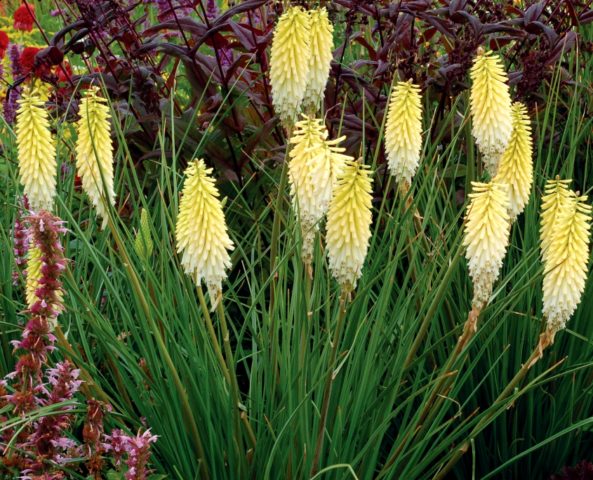
The color range of hard and fibrous leaves of knifofia is whitish dull green or bluish
Shaggy
The plant got its name for the villi that cover the leaf blades. Thanks to this, kniphofia looks decorative. Inflorescences are small, only 3 cm long.
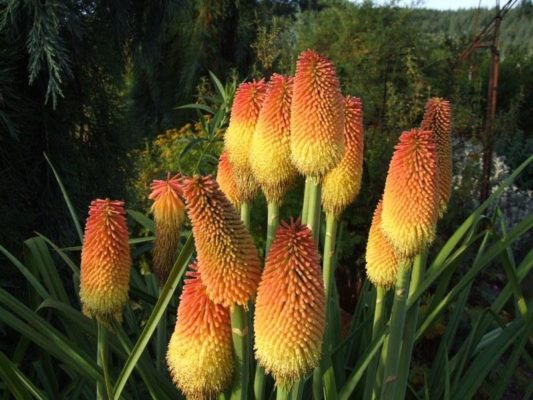
The shaggy knifofia have the lower flowers of yellow color, and the upper ones are red-pink buds.
Isostolic
The variety is distinguished by linear, dull green leaf blades. The pink-yellow flowers of the knifofia resemble a bell or funnel in shape. Buds with long yellow stamens look down.
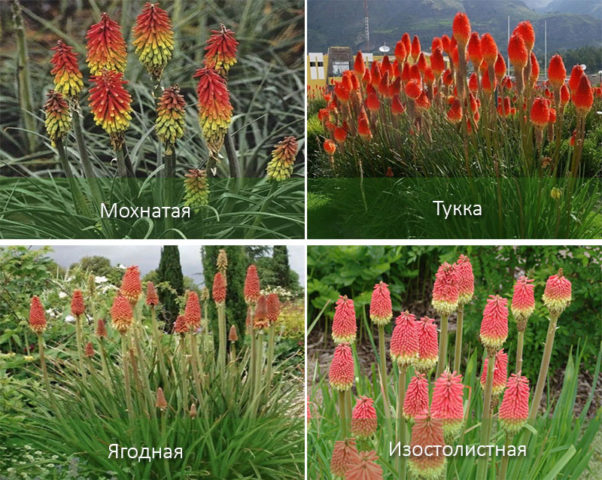
Peduncles of isostolic knifophya grow within 60-100 cm
The best varieties
There are a lot of tritoma varieties. But representatives of such species are especially popular: berry, hybrid, Tukka. In order for flower growers to be able to understand the peculiarities of knifofia, their photos and descriptions are needed.
Flamenco
Flamenco cultivar (Kniphofia flamenco) is a tall plant with red-yellow inflorescences. They are like flaming torches. Flowering begins in July, the last buds can be seen before the first frost. Knifofia Flamenco is not a hassle when planting and leaving.
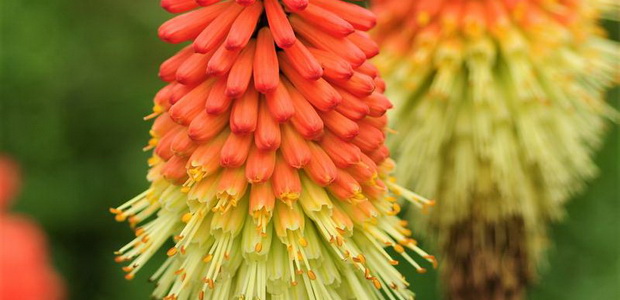
Small buds of the Flamenco variety are located from top to bottom
Popsicle
Popsicke berry cnifophyta is a tall plant, reaching 1 m. The lower part of the buds is yellow. From above they are orange or coral. It all depends on the variety, soil and planting site.
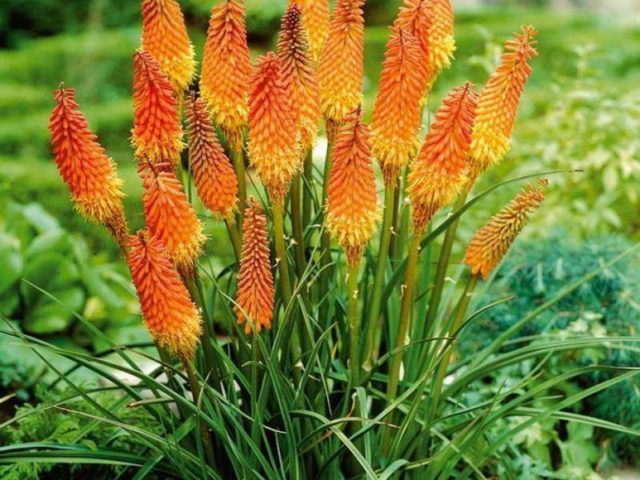
Knifofia Eskimo is a frost-resistant plant, the temperature of - 22 ° C is tolerated practically without damage
Surprise
This variety has a powerful rhizome. Shoots and leaves emerge from the root outlet. The leaf blades are narrow. On a peduncle that grows up to 1 m, there is an inflorescence in the form of an ear. The buds of the cnifophyta are tubular, with protruding stamens, drooping downward. The lower part is yellowish-pink, those flowers that have not yet blossomed are creamy red.
A variety of medium frost resistance, therefore, when grown in the suburbs or central Russia, it must be dug up and removed to a cool room. Knifofia Surprise is grown on lawns, in mixborders. A great option for cutting.
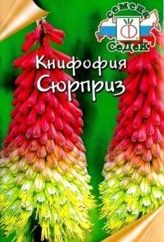
Each drooping bud of the Surprise variety has a wide limb
Flaming fire
The variety of hybrid knifofia Flame Fire got its name for the bright color of small flowers. They are reddish yellow.
Martian
Tritoma Marsianka also refers to perennials. It grows up to 150 cm in height. The leaf blades are dense, leathery, reminiscent of a sword in shape. A peduncle appears from the root rosette, the height of which is about 100 cm. Long ears (up to 25 cm) of knifophya consist of multi-colored bells. Flowers are yellow-pink-red.

Each bud has a large number of long stamens, which makes the Martian variety knifophya decorative
Alcazar
Variety Alcazar (Kniphofia alcazar) is a representative of hybrid knifophy. The height of the bush is within 100 cm. Long-lasting flowering. Most flowers are observed in the period July-August. Bells in a long ear of orange-red color.

The first buds of the knifofia variety Alcazar begin to form at the end of May
Golden Skeeper
Golden Scepter is a hybrid plant. This variety of knifophya reaches 120 cm in height. Large inflorescences consist of bright yellow bells.
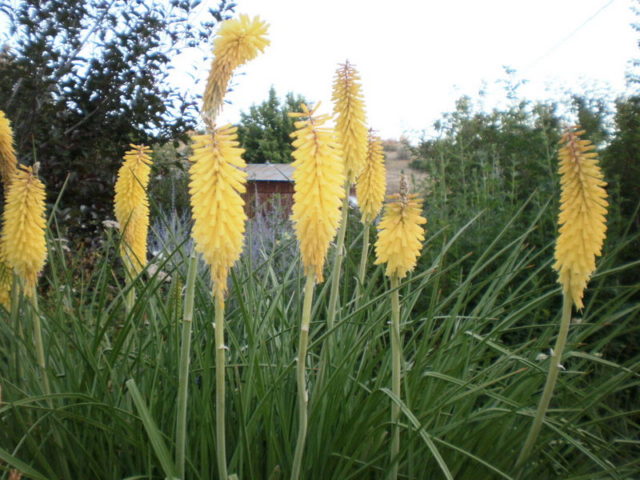
Knifofia Golden Skepter pleases gardeners with her appearance for a long time
Prince maurito
The medium-sized Prince Maurito belongs to the medium-sized hybrids. Knifofia reaches a height of 1.2 m. Flowers in an ear in the form of bells of a dark red or brown hue. The petals look down and slightly to the side.
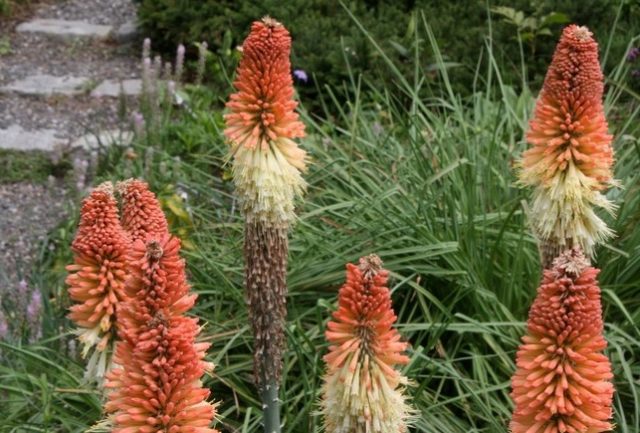
The flowering of the Prince Maurito variety begins in early July and lasts until September
African guest
This is not a variety, but a mixture of different knifophia collected in one package. Plant height varies depending on the species (100-120 cm). When flowering begins, multi-colored ears rise above the bushes.
As part of the mixture:
- yellow - 30%;
- salmon - 30%;
- red 40.
Home grown from seed, African guest cnipophia mix is great for cutting.
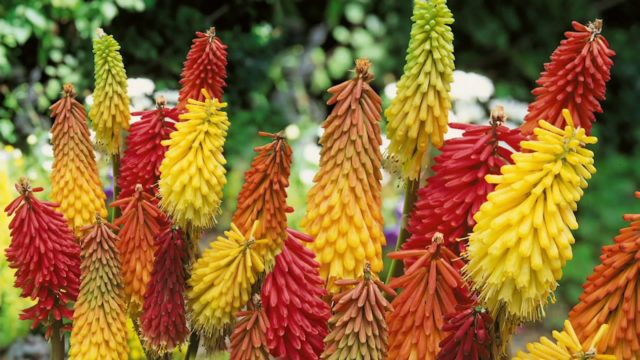
Seedlings of the African guest obtained from the seeds on the site should be placed in increments of 30-40 cm
Application in landscape design
Knifofiya fits perfectly into the design of any site. It can be planted with almost all horticultural crops. Tritoma gets along with:
- irises and sage;
- gypsophila and lupine;
- maned barley, other decorative grasses and ripsalis;
- santolina and gummy resin;
- dahlias and phloxes.
Planting options:
- Plant single tritomas on lawns or small flower beds.
- You can arrange different varieties of knifofia on one bed, making them the central plants.
Neighbors in color should be contrasting
- From the kniphophies, a kind of screen is obtained that will help to divide the garden into zones.
Yellow tritomas go well with red flowers and look good against the backdrop of green bushes

If you need to decorate an alpine slide, then with kniphofia it will look original
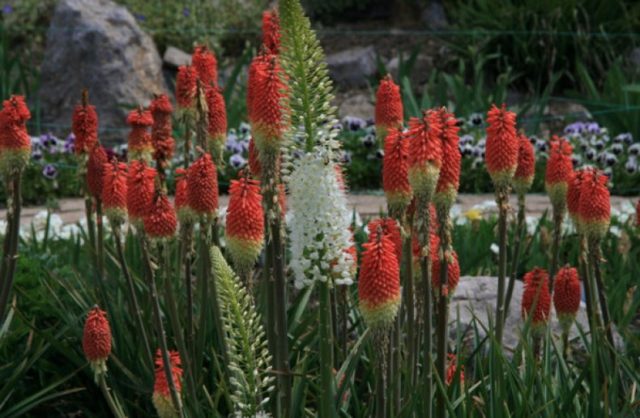
White grandiflora and two-colored tritoma are good neighbors
In the area with reservoirs, plants are planted on the shore.

On a sunny day, multi-colored ears are reflected in the water
Reproduction methods
Getting the seedlings of knifofia yourself is not a problem. For this, you can use both seed and vegetative methods.
For vegetative propagation, you will need a bush that is no more than 5 years old. Depending on the region of cultivation, work begins in the last days of April or in May.
Breeding stages:
- the mother plant is dug out of the ground;
- divided into sockets, each of which must have healthy kidneys;
- shorten the leaf blades;
- planted in pots one at a time;
- place permanently at the beginning of July.

The roots of the rosettes must not be damaged.
Growing knifofia from seeds
The second way of reproduction is planting cniphophy from seeds. It is possible to grow seedlings, although there are some difficulties. Therefore, you need to follow the recommendations of experienced gardeners.
When to sow knifofia for seedlings
They begin to obtain seedlings from seeds in late March or early April. This time is enough for the seedlings to get stronger by the time of planting in open ground.
Tank and soil preparation
Before sowing, shallow boxes with earth are poured over with boiling water. It is advisable to add potassium permanganate to the water so that disinfection is more effective.
The soil needs nutritious. You can use ready-made store formulations. If the soil is prepared independently, then, in addition to humus, sand (for flowability) and wood ash must be added.
Sowing seeds of knifofia for seedlings
Make grooves in the boxes, add seeds. Cover with earth with a layer of no more than 2 cm. To speed up the seedling, you can cover the containers with glass or cellophane. Place on a warm well-lit window.
Seedling care
Seedlings appear in 2-2.5 weeks. You cannot immediately remove the shelter. Seedlings should be accustomed to room temperature gradually. Care comes down to timely watering.
When the plant has 2 true leaves, you need to dive the seedlings into separate cups.
Knifofia does not like dry air, therefore, the seedlings are sprayed from a spray bottle during the entire growing period.
Planting and caring for knifofia in the open field
Kniphofia in Russia is grown outdoors. It adapts well to natural conditions. In recent years, the guest from Africa has become more and more popular.
Recommended timing
Seedlings of thermophilic kniphofia are planted when the soil and air warm up to 10-12 ° C. Adult plants are not afraid of freezing temperatures. When planting, a step of about 40 cm should be observed.
Site selection and preparation
You need to plant plants in a well-lit place. In the shade, the bloom will not be bright enough. This applies not only to flowers, but also to leaves. The place must be protected from drafts.
On the site on the south side, a small elevation is chosen, since the root system rots with excessive moisture. The soil must be nutritious, loose so that water and air pass through.
Algorithm for planting knifofia
The survival rate of the plant and its further development depend on the correct actions. Therefore, you need to follow the algorithm:
- Prepare holes at a distance of 40 cm.
Fill a drainage layer at the bottom of the hole, this is a prerequisite, since the roots suffer from excess moisture
- Top with nutritious soil and pour water.
Nitrogen fertilizers can be applied before planting plants.
- The seedlings should have a clod of soil so that the plants do not experience stress.
- Top up the holes with soil, compact and water again.
- To prevent the near-stem circle of plants from drying out, add mulch.
How to grow knifofia
Gardeners do not have any particular difficulties in growing kniphofia in the open field. The main thing is to timely carry out the traditional events for plants:
- watering and feeding;
- loosening and removing weeds;
- mulching and pruning;
- preparation for winter.
Watering and feeding schedule
Despite the fact that the flower loves moisture, it must be watered carefully. The next irrigation of plants is carried out after the top layer of the soil has dried. In the heat, the amount of watering is increased. It is better to water the plants in the morning, before the sun rises.
As for feeding, the knifofia does not need it only in the first year after planting, if enough nutrients have been introduced. In subsequent years, fertilize in early spring (with nitrogen-containing preparations), while there are no stems, or at the time of bud formation. In the fall, it is advisable to give plants supplements containing potassium.
It is recommended to combine watering with feeding, so the nutrients are better absorbed by the plants.
Loosening and mulching
It is imperative to loosen the soil under the plants. This is one way to retain moisture and kill weeds. Mulching reduces the amount of irrigation, and the grass does not grow as fast. Peat, pebbles can be used as mulch.
Pruning
They begin to form knifofia in the spring. All dry shoots are removed. When the flowering ends, the peduncles are cut off at ground level. If this is not done, even in a state of winter dormancy, old shoots will take food.
Preparing for winter
It is much easier for the inhabitants of the south. For the winter, it is enough to cut the peduncles and cover the root zone with a small layer of mulch.
In central Russia, you will have to act differently. After cutting the peduncles, the leaves are tied and carefully bent to the ground. Then the knifofia is covered with twigs. With the onset of persistent frosts, they are insulated with non-woven fabric and snow.
In the Urals and Siberia, the knifofia does not hibernate in the open field. Plants are transplanted into a suitable container and stored in a cool place until spring.
Diseases and pests
Knifofia is resistant to many diseases and pests, if you follow the rules of agricultural technology. But insects gnawing leaves can settle on it. Insecticides are used to control pests.
Of the diseases, cniphophia is most often affected by root rot. One of the reasons is over-watering. You can get rid of the disease only at the initial stage. The soil around the bushes is treated with fungicides.
Conclusion
Care and cultivation of knifofia will not be difficult. This exotic flower will become a real garden decoration. Of course, when growing new horticultural crops, you need to get acquainted with the characteristics of the plant itself and its agricultural technology.
